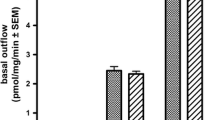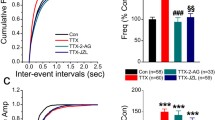Abstract
Electrically stimulated release of neurotransmitters in brain slices normally displays frequency dependence because of progressive activation of autoreceptors by endogenously released transmitter, which is abolished by blockade of autoreceptors. In consequence, the maximal increase caused by an autoreceptor antagonist in percent of the corresponding controls should be greater at higher than at lower frequencies. In the case of γ-aminobutyric acid (GABA), we have previously found a marked deviation from this expectation. Among several explanations envisaged, computer simulation suggested only one to be compatible with the experimental data: the release mechanism may not be able to cope with high demand.
This hypothesis was tested by investigating the frequency dependence of the release of3H-GABA in the presence and absence of a high concentration of the potent GABAB antagonist, CGP 55845, using extremely short stimulation periods. To this end, slices were stimulated with groups of 4 POPS (a POP — pseudo-one-pulse — consists of 4 pulses delivered at 100 Hz). The intervals between the POPs within a group were varied from 60-0.5 s, corresponding to frequencies within the POP group of 0.0167–2 Hz. Under such circumstances, the theoretically expected pattern was indeed observed: the GABAB antagonist abolished the frequency dependence. In a second series of experiments, fractional release per POP was determined when 4–32 POPs were delivered at 2 Hz, with and without CGP 55845. The increase of GABA release elicited by the GABAB antagonist gradually subsided with increasing number of POPS. It was about 50Q7o of that observed during the first 4 POPs in the 4 subsequent ones, and almost nil in the last 16 of a total of 32 POPs.
The results of this study support the hypothesis generated with the help of computer simulation, that release may not be able to keep up with high demand. They further suggest that exhaustion of the releasable transmitter pool occurs surprisingly fast. It is not known whether this phenomenon is physiologically relevant or a consequence of metabolic stress to which the slices are subjected during preparation and superfusion, or of their exposure to transaminase and uptake inhibitors, but it provides an explanation for the anomalies observed in the studies of the effects of GABAB antagonists on3H-GABA release.
Similar content being viewed by others
References
Baumann PA, Koella WP (1980) Feedback control of noradrenaline release as a function of noradrenaline concentration in the synaptic cleft in cortical slices of the rat. Brain Res 189:437–448
Baumann PA, Waldmeier PC (1981) Further evidence for negative feedback control of serotonin release in the central nervous system. Naunyn Schmiedebergs Arch Pharmacol 317:36–43
Baumann PA, Wicki P, Stierlin C, Waldmeier PC (1990) Investigations on GABAB receptor-mediated autoinhibition of GABA release. Naunyn Schmiedebergs Arch Pharmacol 341:88–93
Christen T, Baumann PA, Waldmeier PC (1993) A role for computer simulation in solving the riddles of autoreceptor-mediated regulation of GABA release. Naunyn Schmiedebergs Arch Pharmacol 348:618–627
Froestl W Mickel SJ, von Sprecher G, Bittiger H, Olpe H-R (1992) Chemistry of new GABAB antagonists. Pharmacol Commun 2:52–56
Kelly RB (1993) Storage and release of neurotransmitters. Cell 72:43–53
Limberger N, Trout SJ, Kruk ZL, Starke K (1991) “Real time” measurement of endogenous dopamine release during short trains of pulses in slices of rat neostriatum and nucleus accumbens: Role of auto-inhibition. Naunyn Schmiedebergs Arch Pharmacol 344:623–629
Mayer A, Limberger N, Starke K (1988) Transmitter release patterns of noradrenergic, dopaminergic and cholinergic axons in rabbit brain slices during short pulse trains, and the operation of presynaptic autoreceptors. Naunyn Schmiedebergs Arch Pharmacol 338: 632–643
Nicholls D, Attwell D (1990) The release and uptake of excitatory amino acids. TIPS 11:462–467
Sachs L (1992) Angewandte Statistik, 7th ed. Springer, Berlin Heidelberg New York
Singer EA (1988) Transmitter release from brain slices by single pulses: a powerful method to study presynaptic mechanisms. TIPS 9:274–276
Waldmeier PC, Baumann PA (1990) Presynaptic GABA receptors. Ann NY Acad Sci 604:136–151
Waldmeier PC, Wicki P, Bittiger H, Baumann PA (1992) The regulation of GABA release by GABAB autoreceptors: some intriguing findings and their possible implications. Pharmacol Commun 2:4–7
Waldmeier PC, Hertz C, Wicki P, Grunenwald C, Baumann PA (1993) Autoreceptor-mediated regulation of GABA release: role of uptake inhibition and effects of novel GABAB antagonists. Naunyn Schmiedebergs Arch Pharmacol 347:514–520
Author information
Authors and Affiliations
Additional information
Correspondence to: P. C. Waldmeier at the above address
Rights and permissions
About this article
Cite this article
Waldmeier, P.C., Wicki, P. GABA release in rat cortical slices is unable to cope with demand if the autoreceptor is blocked. Naunyn-Schmiedeberg's Arch. Pharmacol. 349, 583–587 (1994). https://doi.org/10.1007/BF01258463
Received:
Accepted:
Issue Date:
DOI: https://doi.org/10.1007/BF01258463




